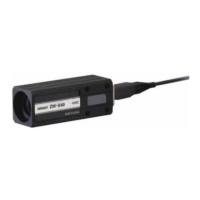Chapter 3 SETTINGS FOR FUNCTIONS
Chapter 3
Setting the Output Conditions
3-33
ZW
User’s Manual
Set the hysteresis width based on the fluctuations in the measured values around the trigger level.
The hysteresis will be applied from the start of the measuring period and will prevent timing input
chattering.
As an example, here is an explanation of the procedure for selecting the "Timing"
trigger type setting.
Operating procedure
Self-down [SELF-D] The sampling period is the period at which the measured value is smaller than
the specified self-trigger level.
Hold measurement is possible without a sync input.
When Self-down is selected, the following items are subsequently displayed:
• Trig level [LEVEL]
Sets the desired self-trigger level.
Range: -999.999999 to 999.999999 (Default value: 0)
• Trig hys [HYS]
Sets the hysteresis width for the self-trigger.
Range: 0 to 999.999999 (Default value: 0.05 % of measurement range)
When a delay time is set, the timing when the measured value
becomes greater than the self-trigger level and the end of the
sampling period will not be synchronous. Sampling will end after the
specified sampling period has elapsed.
Steps
Key operation Display Description
1 - 5 For moving to HOLD, see steps 1 to 5 in p.3-31
6 Press or keys to select either of "TRIG" and
press key.
7 Select "Timing" as the trigger type.
"TYPE" is displayed on the main display and the
current setting value is displayed on the sub-display.
Press / keys to enter the editing mode, and the
sub-display blinks.
Select "TIMING" and press key.
Setting [Display] Description
Self-trigger
level
Measured
value
Hysteresis width
(for self-trigger)
Action point
Return point
Sampling period
ZERORST/ZERORST/
ESCESC
ZERO/ZERO/
SETSET
ZERO/
SET
ZERORST/ZERORST/
ESCESC
ZERO/ZERO/
SETSET
ZERO/
SET

